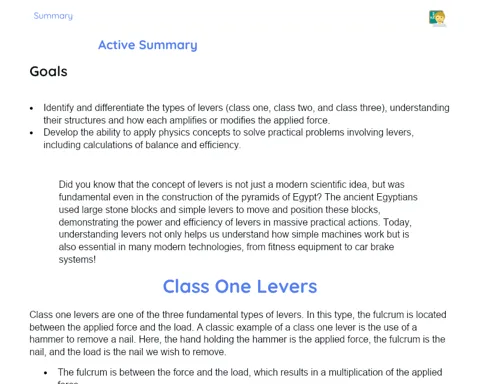Renewable and Non-Renewable Energies | Active Summary
Objectives
1. Clearly differentiate between renewable and non-renewable energy, identifying practical examples of each type.
2. Recognize and name the main sources of renewable energy, highlighting those that are more widespread and those that are under development.
3. Develop critical analysis skills by comparing different types of energies.
4. Encourage creative thinking when discussing possible innovations and solutions for the use of renewable energies.
Contextualization
Did you know that Norway is one of the leading countries in the use of renewable energy? Over 98% of electricity in Norway is generated from renewable sources, primarily through hydroelectric plants. This practical example shows how it is possible and beneficial for a country's environment and economy to predominantly rely on clean energy. This highlights the importance of understanding renewable energies and how we can apply these solutions in various contexts, including our own.
Important Topics
Renewable Energies
Renewable energies are those obtained from sources that are naturally replenished, such as sunlight, wind, tides, and geothermal energy. These energy sources are inexhaustible and generally have a lower environmental impact than non-renewable ones. The ability to use natural resources to generate energy sustainably is crucial to mitigate the global energy crisis and reduce the carbon footprint.
-
Solar: Uses sunlight radiation to generate electricity or heat. It is one of the most promising sources due to its widespread availability.
-
Wind: Wind energy uses the wind to generate electricity through turbines. It is a well-established technology that is widely adopted in many countries.
-
Hydroelectric: Generates electricity through the flow of water in rivers and dams. Although it is one of the oldest sources of renewable energy, it remains one of the most important.
Non-Renewable Energies
Non-renewable energies are sources of energy that deplete over time and cannot be easily replaced. They include oil, coal, and natural gas. Dependence on these sources causes significant harm to the environment, including air pollution and climate change. Transitioning to renewable energies is crucial to reduce reliance on these sources and mitigate their negative impacts.
-
Oil: It is the primary source of energy for transportation and industry. Burning oil releases large amounts of carbon dioxide, contributing to global warming.
-
Coal: One of the most polluting fuels, it is often used for electricity generation. Burning coal also releases toxic substances into the air and soil.
-
Natural Gas: Although it is cleaner than coal and oil, natural gas is still a non-renewable source and its extraction can cause environmental damage.
Environmental and Social Impact
The choice between renewable and non-renewable energies has significant implications for the environment and society. Renewable energies tend to have lower environmental impacts, such as reduced greenhouse gas emissions and the preservation of ecosystems. Additionally, transitioning to renewable energies can create new jobs and economic opportunities. On the other hand, ongoing dependence on non-renewable energies contributes to environmental degradation and energy insecurity.
-
Greenhouse gas emissions: Non-renewable energies are one of the main sources of CO2 emissions, one of the main contributors to global warming.
-
Health impacts: Air pollution caused by burning fossil fuels is directly related to health problems, such as respiratory and cardiovascular diseases.
-
Displacement of communities: Large energy projects, such as hydroelectric plants, can result in the forced displacement of local communities, impacting their lives and cultures.
Key Terms
-
Renewable Energy: Energy sources that are naturally replenished, such as the sun, wind, and water.
-
Non-Renewable Energy: Energy sources that are depleted over time and cannot be easily replaced, such as oil, coal, and natural gas.
-
Environmental Impact: The effects of human activities on the environment, including pollution, soil degradation, and climate change.
To Reflect
-
How does dependence on non-renewable energies impact the energy security of a country?
-
In what ways can the transition to renewable energies contribute to job creation and economic development?
-
What role do governments and companies play in promoting renewable energies and reducing fossil fuel use?
Important Conclusions
-
We reviewed the concept of renewable and non-renewable energies, understanding the importance of transitioning to more sustainable sources.
-
We saw practical examples of how countries like Norway and Iceland are leading the way in using renewable energies and the benefits this brings to the environment and the economy.
-
We discussed the environmental and social impact of non-renewable energies and how transitioning to clean energies can mitigate these problems and create new economic opportunities.
To Exercise Knowledge
- Create an infographic comparing the environmental and social impacts of a coal plant and a wind farm. 2. Write an argumentative essay advocating for the implementation of a solar park in your community. 3. Conduct research on government policies that promote renewable energies and present the findings in a blog post.
Challenge
Eco-Inventor Challenge: Invent a new device or system that creatively uses renewable energy and present your project in a video or presentation to the class.
Study Tips
-
Watch documentaries and read articles about innovations in renewable energies to stay updated and inspired.
-
Participate in online forums or study groups focused on sustainable energy to exchange ideas and learn from other enthusiasts.
-
Try small DIY projects related to solar or wind energy to better understand the functioning and technical challenges involved.



